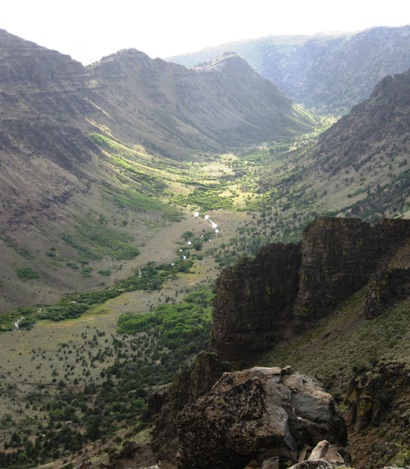
THE MOUNTAIN
When the northern Great Basin country in Oregon's southeast corner fractured into massive escarpments and vast broken valleys, Steens Mountain as we know it, was born. Some sixty to seventy miles long, the mountain consists of a block of land that broke along an eastern fault and tilted westward creating a formidable edge on the east and a long gentle slope on the west. Prior to the breakup, a huge shield volcano built of layer upon layer of lava covered the area.
As the land cracked and the 'scarp' rose, these layers were exposed to eons of weather cycles that included periods of long cold glaciation. Short glaciers cut the crumbling eastern face into steep hanging basins and canyons, while long rivers of ice gouged the western, northern and southern slopes. The ice is gone now, but the huge U-shaped valleys remain and the drop from the summit to the valley to the east is still a nearly vertical face over a mile high.
The current summit of Steens Mountain lies at over 9700 feet. While it is accessed by a gravel road that tourists frequent, the gorges, eastern slopes and most of the western slope have been designated as Wilderness and accessible only by foot. With water easily available in an otherwise desert country, this is a phenomenal place for llama trekking. There is something for everyone from sagebrush steppe to juniper woodland to alpine fell fields. Hiking and packing opportunities range from nearly flat to nearly vertical. There are few trails in the area but much of it is easily negotiated via cross-country travel and by using old cattle paths and animal trails.
PLACES TO GO
Packing opportunities on the mountain are extensive. There are two trails with official trailheads: the Little Blitzen Gorge and Big Indian Gorge. Each of these provides access to spectacular U-shaped glacial valleys where permanent creeks flow past excellent campsites. The Desert Trail also crosses the mountain. It does not have a tread, but is marked with cairns. This is a National Scenic Trail that, when complete, will run from the Mexican border all the way north into Idaho. Much of the Oregon section is complete and offers a spectacular traverse of the southwest portion of the state. 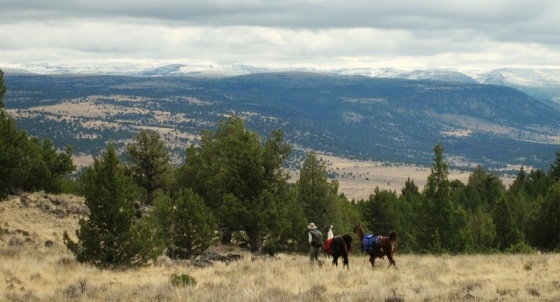
Beyond the trails, packing is limited only by your imagination and navigational skills. The landscape is open and mostly gentle. A person can hike anywhere the terrain permits. Information regarding interesting routes in the vicinity of South Steens Campground can be accessed via the tabs above, although options are much more extensive than described here. The official BLM topographical map of the area can be viewed at Baca Lake Sportsman's Series map. It will provide a clearer idea of the local terrain and further packing options.
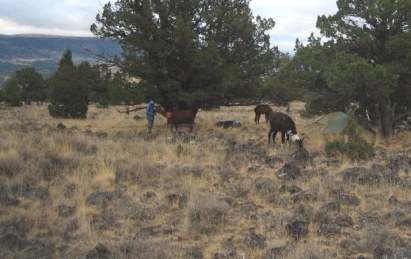 Important considerations are that, in many areas campsites can be hard to find due to the extreme rockiness of the ground, and you may find little forage away from the streams. Although cattle are no longer allowed to graze in this portion of the Wilderness, the vegetation on dry uplands is only slowly recovering. Expect to provide feed for your animals in some form of pellets. Be aware that BLM wilderness restrictions require the use of weed free feed, tethering of livestock 200 feet or more from a water source, and group sizes of no more than twelve people. The area typically dries out in July and comes under fire restrictions until rains begin, usually in late September or October. During this time open fires are allowed only in campground fireboxes. Backpacker stoves are allowed in the backcountry except under extreme conditions. Important considerations are that, in many areas campsites can be hard to find due to the extreme rockiness of the ground, and you may find little forage away from the streams. Although cattle are no longer allowed to graze in this portion of the Wilderness, the vegetation on dry uplands is only slowly recovering. Expect to provide feed for your animals in some form of pellets. Be aware that BLM wilderness restrictions require the use of weed free feed, tethering of livestock 200 feet or more from a water source, and group sizes of no more than twelve people. The area typically dries out in July and comes under fire restrictions until rains begin, usually in late September or October. During this time open fires are allowed only in campground fireboxes. Backpacker stoves are allowed in the backcountry except under extreme conditions.
SOUTH STEENS CAMPGROUND
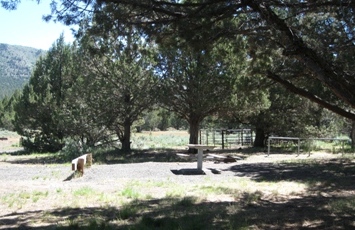
South Steens Campground is an excellent location to stage pack trips from. It has a section designed especially for stock use complete with corrals and hitching rails and is the only public campground in the region that allows pack animals. Located on Steens Loop Road on the western slope of the mountain, it is about 100 miles from the nearest full service amenities. The site is surrounded by wilderness. There are two campground loops, one designed for hikers and one especially outfitted for equestrians, at which llamas are welcome. The two areas are separated by a small meadow and a tiny seasonal stream. Campsites are scattered in the surrounding juniper woods.
There are a total of 36 sites in the campground with 15 in the equestrian area. Potable water is available from pump houses in each loop. All sites are provided with tent pads, picnic tables and fire boxes. Sites are comfortably spaced and most are well shaded.
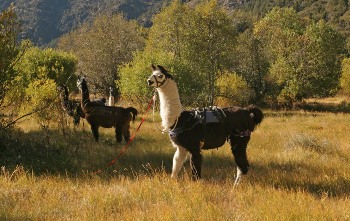 The elevation at the campground is a 5300 feet and the local terrain is gentle with the exception of canyon walls and and the sudden uplift that holds the high alpine regions of the mountain.The surrounding area consists of sagebrush steppe with scattered stands of junipers. Major streams are perennial and bordered with willows. Access to the famous gorges is a mile or so away via trail. Within the gorges stands of aspen run up north facing slopes while willows and cottonwoods grace the stream-sides. The nearly flat valley bottoms provide campsites among grasses and sedges while areas away from the water are vegetated with sagebrush.
The elevation at the campground is a 5300 feet and the local terrain is gentle with the exception of canyon walls and and the sudden uplift that holds the high alpine regions of the mountain.The surrounding area consists of sagebrush steppe with scattered stands of junipers. Major streams are perennial and bordered with willows. Access to the famous gorges is a mile or so away via trail. Within the gorges stands of aspen run up north facing slopes while willows and cottonwoods grace the stream-sides. The nearly flat valley bottoms provide campsites among grasses and sedges while areas away from the water are vegetated with sagebrush.
Elevations on the upper reaches of the mountain rise to nearly 10,000. Visitors from low elevation regions need to be aware of the potential strain unaccustomed elevations may put on them and their llamas. Plan for slower travel than usual and plenty of breaks. In the image below, the campground is located close to the center of the picture. It is easy in the gentle terrain to forget how high you are.
As of January 2014, the daily fee for the campground is $6 per site. Use of sites is on a first come first served basis. Neither reservations nor holding campsites for arrival of other groups is allowed. High use periods include early July around Independence day and the beginning of hunting season in September. People are advised to groom their llamas as thoroughly as possible before arrival. 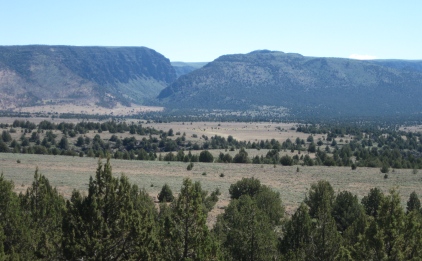 This is to prevent the spread of weeds. Combings should be packed out of the Wilderness. In the campground they should be carefully placed in the trash. It is also advisable to groom carefully before leaving the campground area for the same reason. There is bur buttercup in the campground and may be medusahead nearby. Nobody wants these in their pastures if they can avoid it. Only locally purchased weed free hay or pelletized feed may be used. Manure from trailers may not be swept out on BLM lands, however there is an official dung heap at the campground and a public wheelbarrow to transport debris. People are expected to police their campsites and keep them clean. In the rare case of a full campground 'primitive' campsites may be found within a mile or so of the campground along the Little Blitzen River or Indian Creek. This is to prevent the spread of weeds. Combings should be packed out of the Wilderness. In the campground they should be carefully placed in the trash. It is also advisable to groom carefully before leaving the campground area for the same reason. There is bur buttercup in the campground and may be medusahead nearby. Nobody wants these in their pastures if they can avoid it. Only locally purchased weed free hay or pelletized feed may be used. Manure from trailers may not be swept out on BLM lands, however there is an official dung heap at the campground and a public wheelbarrow to transport debris. People are expected to police their campsites and keep them clean. In the rare case of a full campground 'primitive' campsites may be found within a mile or so of the campground along the Little Blitzen River or Indian Creek.
|